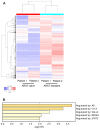H19 in Serum Extracellular Vesicles Reflects Resistance to AR Axis-targeted Therapy Among CRPC Patients
- PMID: 37643783
- PMCID: PMC10464938
- DOI: 10.21873/cgp.20397
H19 in Serum Extracellular Vesicles Reflects Resistance to AR Axis-targeted Therapy Among CRPC Patients
Abstract
Background/aim: We aimed to evaluate the changes of androgen receptor (AR) signaling-related long non-coding RNAs (lncRNAs) in serum extracellular vesicles (EVs) from prostate cancer (PC) patients, in order to identify novel biomarkers for AR axis-targeted therapy (ARAT)-resistance among castration-resistant PC (CRPC) patients.
Patients and methods: EVs were isolated from 2 patients before and after acquiring ARAT-resistance. RNA profiling of EVs was performed by RNA-sequencing. The expression levels of selected lncRNAs in EVs were analyzed by digital droplet PCR (ddPCR) in 58 localized and 14 metastatic PC patients at diagnosis, 7 ARAT-naïve and 6 ARAT-resistant CRPC patients. LncRNA H19 expression in PC tissue was examined using published data. In order to analyze the role of H19, the prognosis was analyzed in PC patients and proteomic analysis was performed in 22Rv1 PC cells.
Results: RNA-sequencing revealed that AR-regulated RNAs were most enriched in EVs after acquiring ARAT-resistance. Among them, up-regulation of AR signaling-related lncRNAs (PCAT1, H19, HOXA-11AS, ZEB1-AS1, ARLNC1, PART1, CTBP1-AS and PCA3) was confirmed by ddPCR. H19 contained in EVs (EV-H19) was significantly increased among ARAT-resistant patients compared to ARAT-naïve CRPC or metastatic PC patients. In PC tissue, H19 was negatively correlated with AR protein and AR-activity score and up-regulated in neuroendocrine CRPC tissue with low AR expression. Furthermore, EV-H19 expression was significantly associated with worse outcome to androgen-deprivation therapy. Proteomic analysis demonstrated that H19 knockdown enhanced PC-related protein expression.
Conclusion: EV-H19 may negatively correlate with AR-signaling activity and could be a marker to diagnose ARAT-resistance among CRPC patients.
Keywords: CRPC; H19; Prostate cancer; RNA-sequencing; androgen receptor axis-targeted therapy; extracellular vesicles.
Copyright © 2023, International Institute of Anticancer Research (Dr. George J. Delinasios), All rights reserved.
Conflict of interest statement
The Authors declare that there are no conflicts of interest in this study.
Figures





Similar articles
-
Diagnostic potential of SDHB mRNA contained in serum extracellular vesicles among patients with prostate cancer.Prostate. 2024 Dec;84(16):1515-1524. doi: 10.1002/pros.24792. Epub 2024 Sep 15. Prostate. 2024. PMID: 39279231
-
Arginine vasopressin receptor 1a is a therapeutic target for castration-resistant prostate cancer.Sci Transl Med. 2019 Jun 26;11(498):eaaw4636. doi: 10.1126/scitranslmed.aaw4636. Sci Transl Med. 2019. PMID: 31243151 Free PMC article.
-
High levels of the AR-V7 Splice Variant and Co-Amplification of the Golgi Protein Coding YIPF6 in AR Amplified Prostate Cancer Bone Metastases.Prostate. 2017 May;77(6):625-638. doi: 10.1002/pros.23307. Epub 2017 Feb 1. Prostate. 2017. PMID: 28144969
-
Targeting the androgen receptor signaling pathway in advanced prostate cancer.Am J Health Syst Pharm. 2022 Jul 22;79(15):1224-1235. doi: 10.1093/ajhp/zxac105. Am J Health Syst Pharm. 2022. PMID: 35390118 Review.
-
Understanding the mechanisms of androgen deprivation resistance in prostate cancer at the molecular level.Eur Urol. 2015 Mar;67(3):470-9. doi: 10.1016/j.eururo.2014.09.049. Epub 2014 Oct 8. Eur Urol. 2015. PMID: 25306226 Free PMC article. Review.
Cited by
-
Gene Expression Profiling Regulated by lncRNA H19 Using Bioinformatic Analyses in Glioma Cell Lines.Cancer Genomics Proteomics. 2024 Nov-Dec;21(6):608-621. doi: 10.21873/cgp.20477. Cancer Genomics Proteomics. 2024. PMID: 39467632 Free PMC article.
-
Exosomal Liquid Biopsy in Prostate Cancer: A Systematic Review of Biomarkers for Diagnosis, Prognosis, and Treatment Response.Int J Mol Sci. 2025 Jan 18;26(2):802. doi: 10.3390/ijms26020802. Int J Mol Sci. 2025. PMID: 39859516 Free PMC article.
-
Prognostic Impact of H19/Cell Adhesion Molecules Circuitry on Prostate Cancer Biopsy.Biomedicines. 2024 Oct 12;12(10):2322. doi: 10.3390/biomedicines12102322. Biomedicines. 2024. PMID: 39457633 Free PMC article.
-
Early Detection, Precision Treatment, Recurrence Monitoring: Liquid Biopsy Transforms Colorectal Cancer Therapy.Curr Cancer Drug Targets. 2025;25(6):586-619. doi: 10.2174/0115680096295070240318075023. Curr Cancer Drug Targets. 2025. PMID: 38623975 Review.
-
Castration-resistant prostate cancer monitoring by cell-free circulating biomarkers.Front Oncol. 2024 Sep 10;14:1394292. doi: 10.3389/fonc.2024.1394292. eCollection 2024. Front Oncol. 2024. PMID: 39319053 Free PMC article. Review.
References
-
- Schaeffer EM, Srinivas S, Adra N, An Y, Barocas D, Bitting R, Bryce A, Chapin B, Cheng HH, D’Amico AV, Desai N, Dorff T, Eastham JA, Farrington TA, Gao X, Gupta S, Guzzo T, Ippolito JE, Kuettel MR, Lang JM, Lotan T, McKay RR, Morgan T, Netto G, Pow-Sang JM, Reiter R, Roach M, Robin T, Rosenfeld S, Shabsigh A, Spratt D, Teply BA, Tward J, Valicenti R, Wong JK, Berardi RA, Shead DA, Freedman-Cass DA. NCCN guidelines(R) insights: Prostate cancer, version 1.2023. J Natl Compr Canc Netw. 2022;20(12):1288–1298. doi: 10.6004/jnccn.2022.0063. - DOI - PubMed
-
- Zhao SG, Sperger JM, Schehr JL, McKay RR, Emamekhoo H, Singh A, Schultz ZD, Bade RM, Stahlfeld CN, Gilsdorf CS, Hernandez CI, Wolfe SK, Mayberry RD, Krause HM, Bootsma M, Helzer KT, Rydzewski N, Bakhtiar H, Shi Y, Blitzer G, Kyriakopoulos CE, Kosoff D, Wei XX, Floberg J, Sethakorn N, Sharifi M, Harari PM, Huang W, Beltran H, Choueiri TK, Scher HI, Rathkopf DE, Halabi S, Armstrong AJ, Beebe DJ, Yu M, Sundling KE, Taplin ME, Lang JM. A clinical-grade liquid biomarker detects neuroendocrine differentiation in prostate cancer. J Clin Invest. 2022;132(21):e161858. doi: 10.1172/JCI161858. - DOI - PMC - PubMed
MeSH terms
Substances
LinkOut - more resources
Full Text Sources
Research Materials
